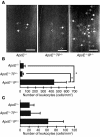Roles of thromboxane A(2) and prostacyclin in the development of atherosclerosis in apoE-deficient mice
- PMID: 15372102
- PMCID: PMC516261
- DOI: 10.1172/JCI21446
Roles of thromboxane A(2) and prostacyclin in the development of atherosclerosis in apoE-deficient mice
Abstract
Production of thromboxane (TX) A2 and PG I2/prostacyclin (PGI2) is increased in patients with atherosclerosis. However, their roles in atherogenesis have not been critically defined. To examine this issue, we cross-bred atherosclerosis-prone apoE-deficient mice with mice deficient in either the TXA receptor (TP) or the PGI receptor (IP). Although they showed levels of serum cholesterol and triglyceride similar to those of apoE-deficient mice, apoE-/-TP-/- mice exhibited a significant delay in atherogenesis, and apoE-/-IP-/- mice exhibited a significant acceleration in atherogenesis compared with mice deficient in apoE alone. The plaques in apoE-/-IP-/- mice showed partial endothelial disruption and exhibited enhanced expression of ICAM-1 and decreased expression of platelet endothelial cell adhesion molecule 1 (PECAM-1) in the overlying endothelial cells compared with those of apoE-/-TP-/- mice. Platelet activation with thrombin ex vivo revealed higher and lower sensitivity for surface P-selectin expression in platelets of apoE-/-IP-/- and apoE-/-TP-/- mice, respectively, than in those of apoE-/- mice. Intravital microscopy of the common carotid artery revealed a significantly greater number of leukocytes rolling on the vessel walls in apoE-/-IP-/- mice than in either apoE-/-TP-/- or apoE-/- mice. We conclude that TXA2 promotes and PGI2 prevents the initiation and progression of atherogenesis through control of platelet activation and leukocyte-endothelial cell interaction.
Figures





References
-
- Ross R. Atherosclerosis is an inflammatory disease. Am. Heart. J. 1999;138:S419–S420. - PubMed
-
- FitzGerald GA, Smith B, Pedersen AK, Brash AR. Increased prostacyclin biosynthesis in patients with severe atherosclerosis and platelet activation. N. Engl. J. Med. 1984;310:1065–1068. - PubMed
-
- Belton O, Byrne D, Kearney D, Leahy A, Fitzgerald DJ. Cyclooxygenase-1 and -2-dependent prostacyclin formation in patients with atherosclerosis. Circulation. 2000;102:840–845. - PubMed
-
- Plump AS, et al. Severe hypercholesterolemia and atherosclerosis in apolipoprotein E-deficient mice created by homologous recombination in ES cells. Cell. 1992;71:343–353. - PubMed
-
- Zhang SH, Reddick RL, Piedrahita JA, Maeda N. Spontaneous hypercholesterolemia and arterial lesions in mice lacking apolipoprotein E. Science. 1992;258:468–471. - PubMed
Publication types
MeSH terms
Substances
LinkOut - more resources
Full Text Sources
Other Literature Sources
Molecular Biology Databases
Miscellaneous

